DODGE DURANGO 2014 3.G User Guide
Manufacturer: DODGE, Model Year: 2014, Model line: DURANGO, Model: DODGE DURANGO 2014 3.GPages: 188, PDF Size: 3.8 MB
Page 151 of 188
CAUTION!
• Do not use a portable battery booster pack or any other booster source with a systemvoltage greater than 12 Volts or damage to the battery, starter motor, alternator or
electrical system may occur.
• Failure to follow these procedures could result in damage to the charging system of the booster vehicle or the discharged vehicle.
• Accessories that can be plugged into the vehicle power outlets draw power from the vehicle’s battery, even when not in use (e.g., cellular phones, etc.). Eventually, if
plugged in long enough, the vehicle’s battery discharges sufficiently to degrade
battery life and/or prevent the engine from starting.
WARNING!
• When temperatures are below the freezing point, electrolyte in a discharged batterymay freeze. Do not attempt jump-starting because the battery could rupture or
explode and cause personal injury. Battery temperature must be brought above the
freezing point before attempting a jump-start.
• Take care to avoid the radiator cooling fan whenever the hood is raised. It can start anytime the ignition switch is on. You can be injured by moving fan blades.
• Remove any metal jewelry, such as watch bands or bracelets, that might make an
inadvertent electrical contact. You could be severely injured.
• Batteries contain sulfuric acid that can burn your skin or eyes and generate hydrogen
gas which is flammable and explosive. Keep open flames or sparks away from the
battery.
• Do not allow vehicles to touch each other as this could establish a ground connection
and personal injury could result.
• Failure to follow this procedure could result in personal injury or property damage
due to battery explosion.
• Do not connect the cable to the negative post (-) of the discharged battery. The resulting electrical spark could cause the battery to explode and could result in
personal injury.
WHAT TO DO IN EMERGENCIES
149
Page 152 of 188
MANUAL PARK RELEASE 8-SPEED
In order to push or tow the vehicle in cases where the transmission will not shift out of PARK
(such as a dead battery), a Manual Park Release is available. The Manual Park Release is
located in the center console under an access cover.
Follow these steps to use the Manual Park Release:
1. Lift upward on the access cover, located in the rear portion of the center console torelease it from the console hinges.
2.
Using a screwdriver or similar tool, push
the metal latch in towards the tether strap.
3. While the metal latch is in the open posi- tion, simultaneously pull upwards on the
tether strap until it clicks and releases
out of the park position.
NOTE:
To prevent the vehicle from rolling uninten-
tionally, firmly apply the parking brake.
To Disengage the Manual Park Release
Lever:
1.
Pull upward on the tether while pushing the
release latch towards the tether to unlock
the lever.
2.Once the tension has been released and
the lever has been unlocked, push the lever
all the way down to be sure it is stowed
properly and locks into position.
3. Reinstall the access cover by pushing it downward until it is locked into place.
WHAT TO DO IN EMERGENCIES
150
Page 153 of 188
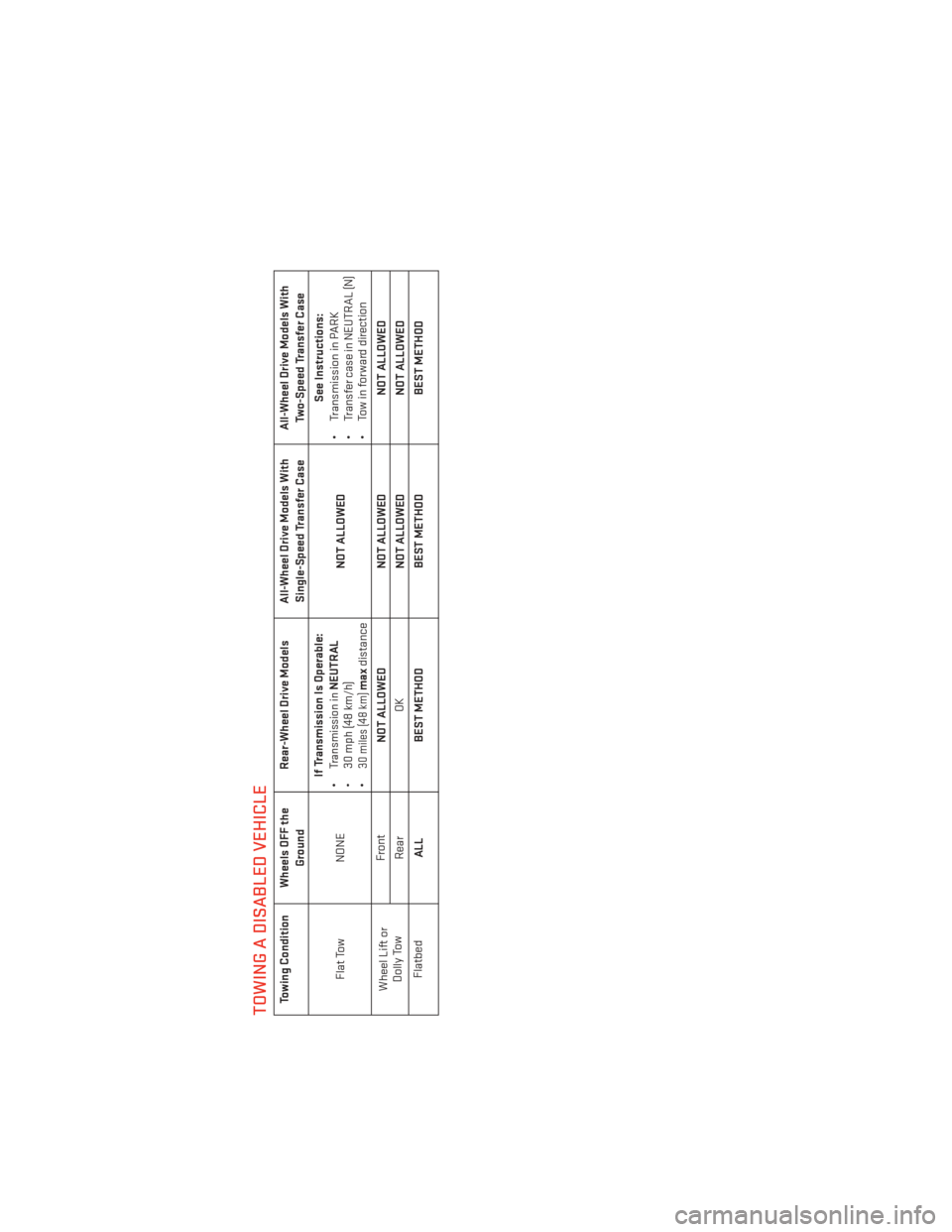
TOWING A DISABLED VEHICLETowing Condition Wheels OFF theGroundRear-Wheel Drive Models All-Wheel Drive Models With
Single-Speed Transfer Case All-Wheel Drive Models With
Two-Speed Transfer Case
Flat Tow NONEIf Transmission Is Operable:
•
Transmission in
NEUTRAL
•
30 mph (48 km/h)
•
30 miles (48 km)
max distance NOT ALLOWED
See Instructions:
• Transmission in PARK
• Transfer case in NEUTRAL (N)
• Tow in forward direction
Wheel Lift or Dolly Tow Front
NOT ALLOWED NOT ALLOWEDNOT ALLOWED
Rear OK
NOT ALLOWED NOT ALLOWED
Flatbed ALLBEST METHOD BEST METHODBEST METHOD
WHAT TO DO IN EMERGENCIES
151
Page 154 of 188
FREEING A STUCK VEHICLE
• If your vehicle becomes stuck in mud, sand or snow, it can often be moved by a rockingmotion. Turn your steering wheel right and left to clear the area around the front wheels.
Then, move the shift lever/gear selector back and forth between REVERSE and DRIVE.
Using minimal accelerator pedal pressure to maintain the rocking motion, without
spinning the wheels, is most effective.
• Allow the engine to idle with the transmission shift lever/gear selector in NEUTRAL for at least one minute after every five rocking-motion cycles. This minimizes overheating and
reduce the risk of transmission failure during prolonged efforts to free a stuck vehicle.
NOTE:
If your vehicle is equipped with Electronic Stability Control (ESC) then press the "ESC Off"
switch, to place the Electronic Stability Control (ESC) system in "Partial Off" mode, before
rocking the vehicle.
CAUTION!
Revving the engine or spinning the wheels too fast may lead to transmission overheating
and failure. It can also damage the tires. Do not spin the wheels above 30 mph (48 km/h)
while in gear (no transmission shifting occurring).
WARNING!
Fast spinning tires can be dangerous. Forces generated by excessive wheel speeds may
cause tire damage or failure. A tire could explode and injure someone. Do not spin your
vehicle's wheels faster than 30 mph (48 km/h) when you are stuck. Do not let anyone
near a spinning wheel, no matter what the speed.
WHAT TO DO IN EMERGENCIES
152
Page 155 of 188

EVENT DATA RECORDER (EDR)
This vehicle is equipped with an Event Data Recorder (EDR). The main purpose of an EDR is
to record, in certain crash or near crash-like situations, such as an air bag deployment or
hitting a road obstacle, data that will assist in understanding how a vehicle’s systems
performed. The EDR is designed to record data related to vehicle dynamics and safety
systems for a short period of time, typically 30 seconds or less. The EDR in this vehicle is
designed to record such data as:
• How various systems in your vehicle were operating.
• Whether or not the driver and passenger safety belts were buckled/fastened.
• How far (if at all) the driver was depressing the accelerator and/or brake pedal.
• How fast the vehicle was traveling.
These data can help provide a better understanding of the circumstances in which crashes
and injuries occur.
NOTE:
EDR data is recorded by your vehicle only if a non-trivial crash situation occurs; no data is
recorded by the EDR under normal driving conditions and no personal data (e.g. name,
gender, age, and crash location) is recorded. However, other parties, such as law enforce-
ment, could combine the EDR data with the type of personally identifying data routinely
acquired during a crash investigation.
To read data recorded by an EDR, special equipment is required, and access to the vehicle or
the EDR is needed. In addition to the vehicle manufacturer, other parties such as law enforce-
ment, that have the special equipment, can read the information if they have access to the
vehicle or the EDR.
CAP-LESS FUEL FILL FUNNEL
The funnel for the Cap-Less Fuel System is located on the jacking tool kit. If your vehicle is
out of fuel and an auxiliary fuel can is needed, insert the funnel into the filler neck and
proceed to fill the vehicle.
WHAT TO DO IN EMERGENCIES
153
Page 156 of 188
OPENING THE HOOD
1. Pull the hood release lever located belowthe steering wheel at the base of the in-
strument panel.
2. Reach into the opening beneath the cen- ter of the hood and push and hold the
safety latch lever to the left while lifting
the hood at the same time.
WARNING!
Be sure the hood is fully latched before driving your vehicle. If the hood is not fully
latched, it could open when the vehicle is in motion and block your vision. Failure to
follow this warning could result in serious injury or death.
MAINTAINING YOUR VEHICLE
154
Page 157 of 188
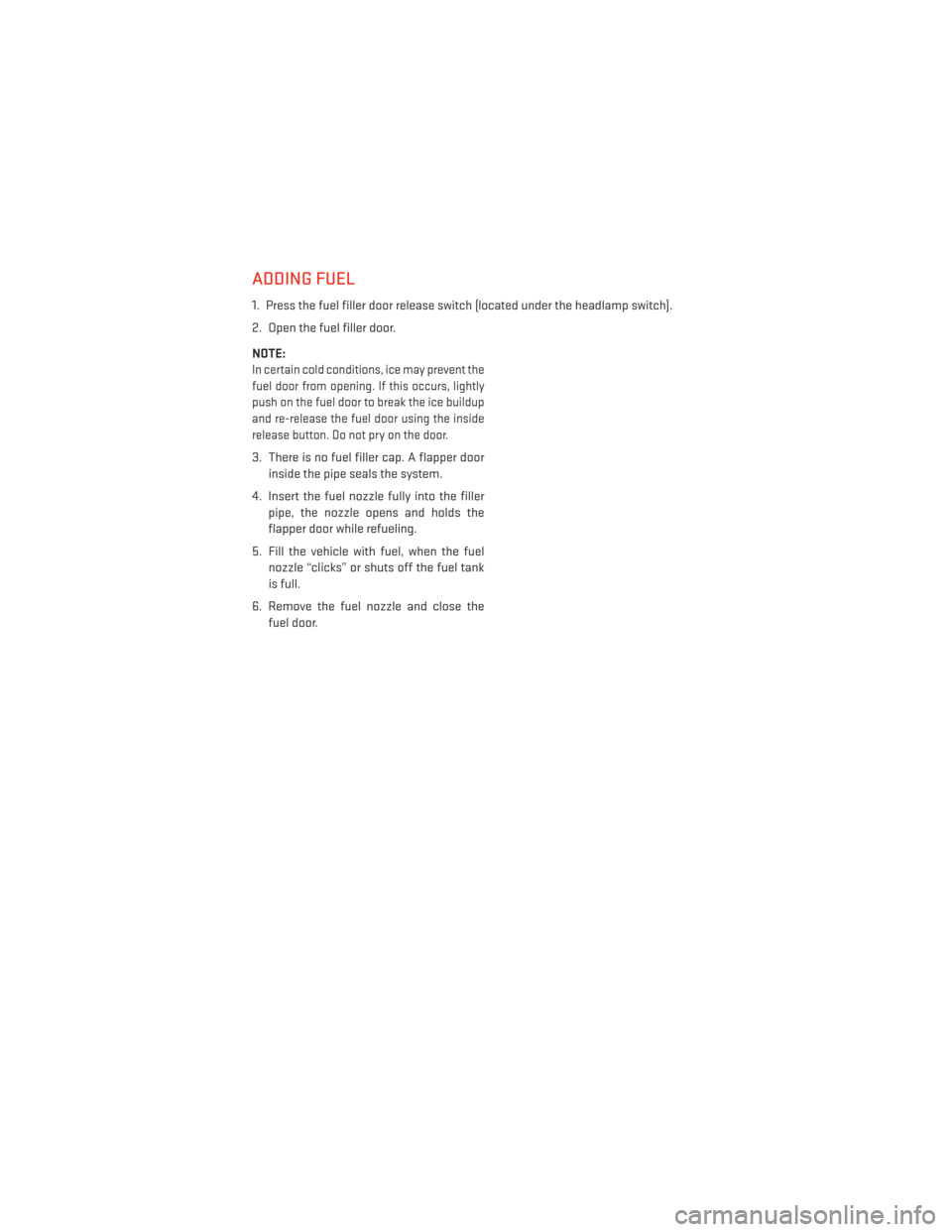
ADDING FUEL
1. Press the fuel filler door release switch (located under the headlamp switch).
2. Open the fuel filler door.
NOTE:
In certain cold conditions, ice may prevent the
fuel door from opening. If this occurs, lightly
push on the fuel door to break the ice buildup
and re-release the fuel door using the inside
release button. Do not pry on the door.
3. There is no fuel filler cap. A flapper doorinside the pipe seals the system.
4. Insert the fuel nozzle fully into the filler pipe, the nozzle opens and holds the
flapper door while refueling.
5. Fill the vehicle with fuel, when the fuel nozzle “clicks” or shuts off the fuel tank
is full.
6. Remove the fuel nozzle and close the fuel door.
MAINTAINING YOUR VEHICLE
155
Page 158 of 188
Fuel Door Emergency Release
• To manually open the fuel door, remove the storage bin located in the left rear cargo area.
• Pull the release cable located in the storage bin opening.
MAINTAINING YOUR VEHICLE
156
Page 159 of 188
ENGINE COMPARTMENT3.6L ENGINE
MAINTAINING YOUR VEHICLE
157
Page 160 of 188

5.7L ENGINE
MAINTAINING YOUR VEHICLE
158